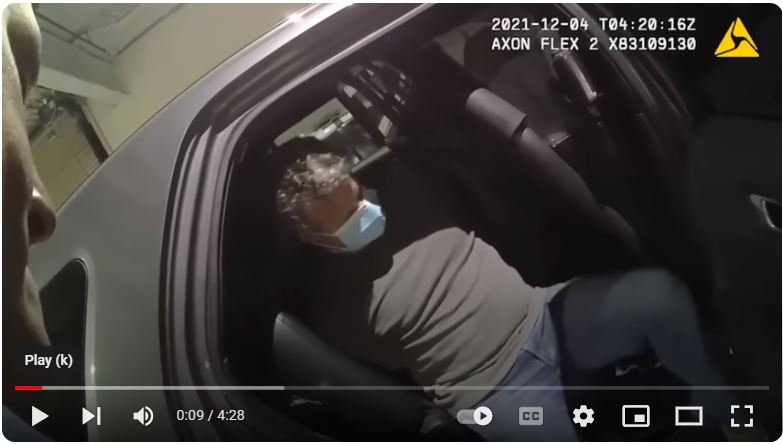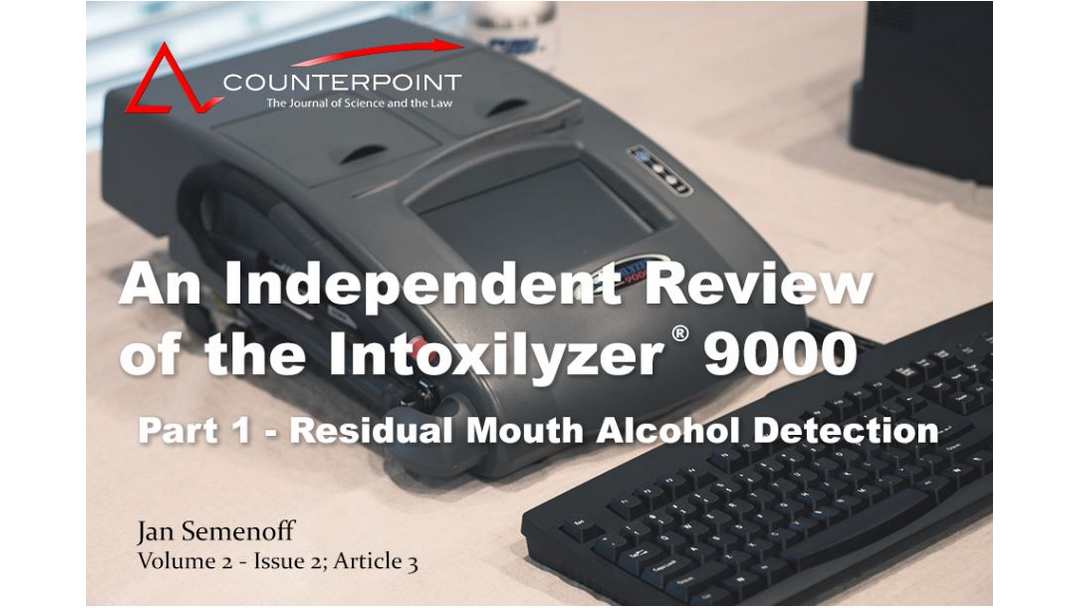An Independent Review of the Intoxilyzer 9000
Part 1 – Residual mouth alcohol detection
Counterpoint Volume 2; Issue 2 – Article 3 (August 2017)
An article in the Core Skills III-2 Module
Jan Semenoff, BA, EMA
Forensic Criminalist
The opportunity to conduct an independent analysis and performance review of a new breath alcohol testing device is rare, particularly the higher-end, evidentiary-level units.
Access to these technologies is stringently controlled by both their manufacturers and the police and government agencies that control them.
Additionally, state agencies are often reluctant to publish the results of their official assessments and analysis of the devices.
When given the opportunity to perform such a review on a new Intoxilyzer 9000, I designed a series of experiments to quickly analyze the overall performance of the device.
I attended the device’s location with colleague Tom Workman (1948 – 2019) to determine its suitability and reliability in a number of key areas, including:
- Overall design and ease of use
- Accuracy in determining in vitro [2] BrAC levels using a simulator
- The ability of the device to determine the presence of Fresh Mouth Alcohol using a Residual
- Alcohol Detection System (RADS) or the so-called “slope detector”.
- Reliability in reporting BrAC [3] readings that are highly specific to ethanol
- The effect of Radio Frequency Interference on the device [4]
This article will provide a general overview of the operational characteristics of the Intoxilyzer 9000. We will additionally look at the apparent accuracy of the device using simulator readings, and examine the ability of the device to “flag” false positive reading caused by fresh mouth alcohol contamination.
Read the rest of Part One here
Parts two and three are in the drop down menu at the site but not easy to notice. The links are below if you have trouble.
Part Two and Part Three will examine the unit’s specificity towards ethanol detection and its ability to identify the presence of an interferent chemical, and the capacity of the device to detect Radio Frequency Interference.
Related Articles
No Results Found
The page you requested could not be found. Try refining your search, or use the navigation above to locate the post.
More Posts

New laws for 2024 – Buckle Up
States nationwide will welcome the upcoming year with the implementation of laws tackling crucial matters such as gun violence, book bans, and the introduction of gender-neutral toy sections. These legislative advancements are set to take effect throughout 2024,...

Biden Issues More Cannabis Pardons but…
Joe Biden has extended pardons for individuals charged with simple cannabis possession and use, yet disappointingly, he has refrained from granting clemency to those currently incarcerated for cannabis-related offenses.In an extension of the previous year's extensive...

Working With and Not Against, IRS Revenue Code 280E
Cannabis operators face IRS Revenue Code 280E restrictions, but smart tax planning and strategies allow entrepreneurs to mitigate its impact on their business.Komorn Law is Michigan's top cannabis law firms when it comes to licensing, consulting and legal defense....

Department of Attorney General Prepares for MLEAC Accreditation
LANSING – The Michigan Department of Attorney General (DAG) recently welcomed a team of assessors from the Michigan Law Enforcement Accreditation Commission (MLEAC). The assessors came to examine all aspects of the Department’s compliance with the MLEAC standards in...

Oklahoma’s wild marijuana market is about to shrivel
The world's weed market, once booming with nearly 14,000 licensed medical marijuana businesses at its peak, has experienced a steady decline since Oklahoma voters overwhelmingly rejected a recreational legalization referendum in March. Heightened enforcement by state...

400K settlement after being arrested for a DUI, even though he passed breath and blood tests
A Colorado man is poised to receive a $400,000 settlement from city authorities after being wrongfully arrested for a DUI, even though he had passed both a breath and blood test.According to the complaint, Elias was driving southbound on College Avenue in Fort Collins...

When Being Questioned by the Police: Can They Lie to You?
When Being Questioned by the Police: Can They Lie to You? Introduction In the United States, police officers are generally allowed to lie to suspects during interrogations. This is a controversial practice, but it has been upheld by the Supreme Court. There are some...

Ohio Bill Introduced to Allow Each City to Ban Marijuana
With just over a week until Ohio’s voter-approved marijuana legalization law takes effect, a lawmaker has introduced a bill that would allow individual municipalities to locally ban the use and home cultivation of cannabis in their jurisdictions. The legislation aims...

Appeals Court – Detroit’s Asset Forfeiture Violates Due Process
A federal circuit judge writes that Detroit's vehicle seizure scheme "is simply a money-making venture—one most often used to extort money from those who can least afford it." A panel of federal appellate judges ruled that Detroit's practice of seizing people's cars...

NEWS RELEASE: USSC Adopts 2023 Amendments
WASHINGTON, D.C. ― Equipped with a quorum of Commissioners for the first time since 2018, the bipartisan United States Sentencing Commission voted today to promulgate amendments to the federal sentencing guidelines. “The Sentencing Commission is back in business,”...









